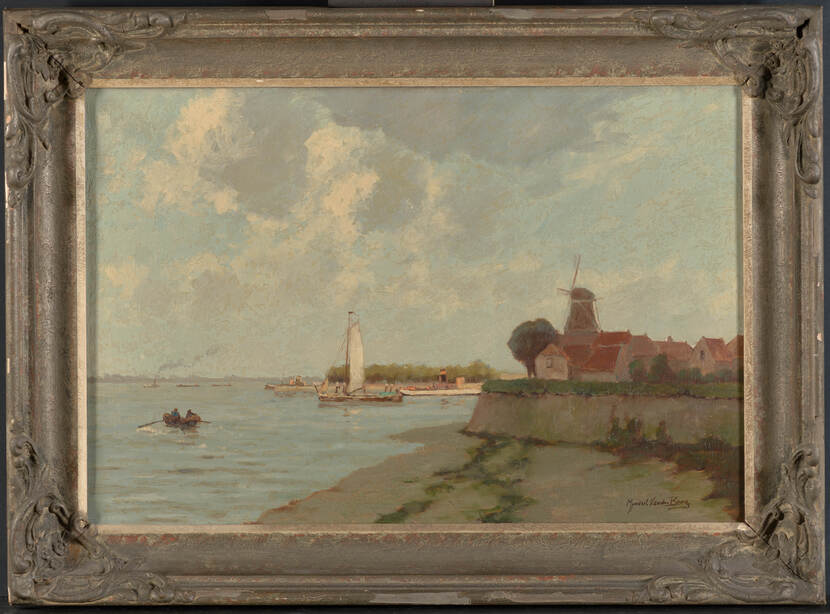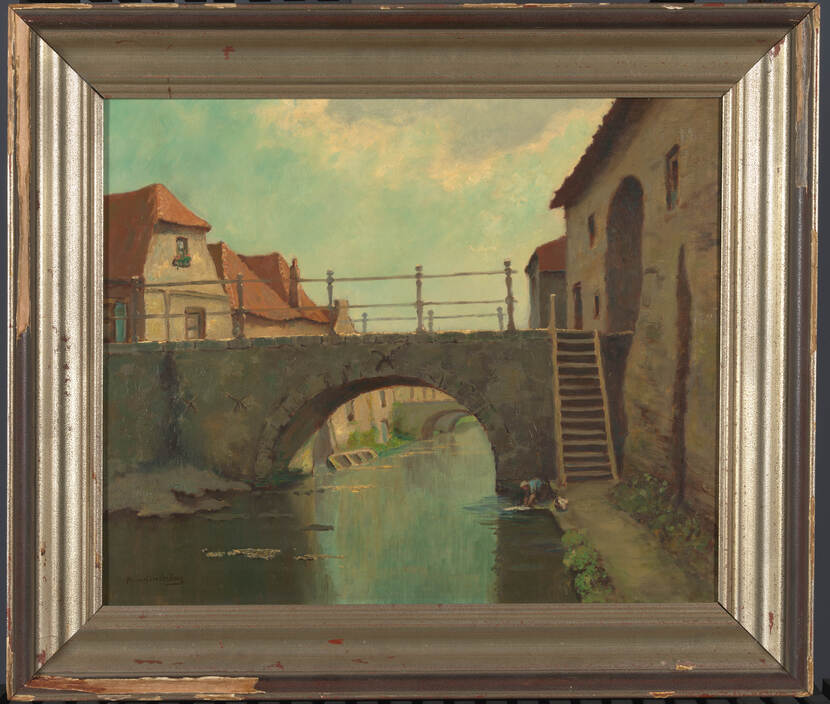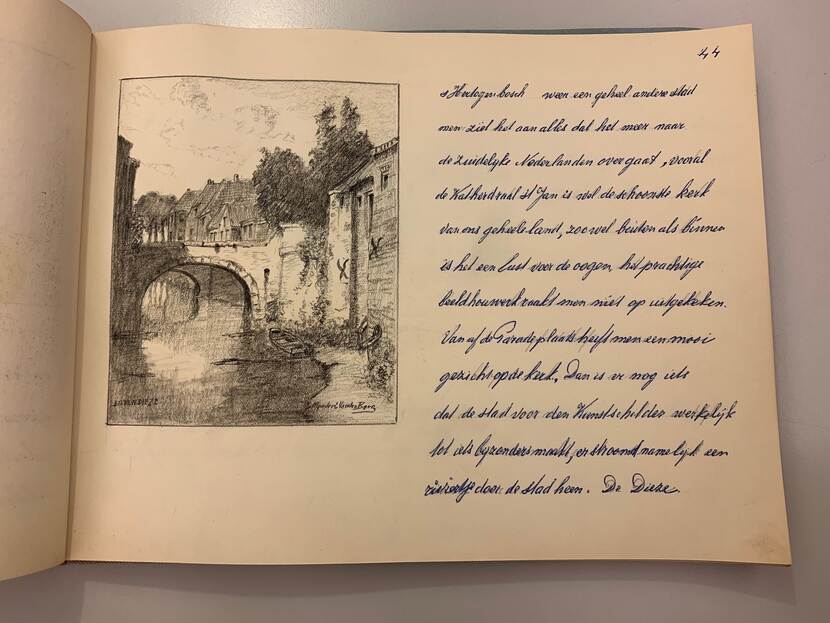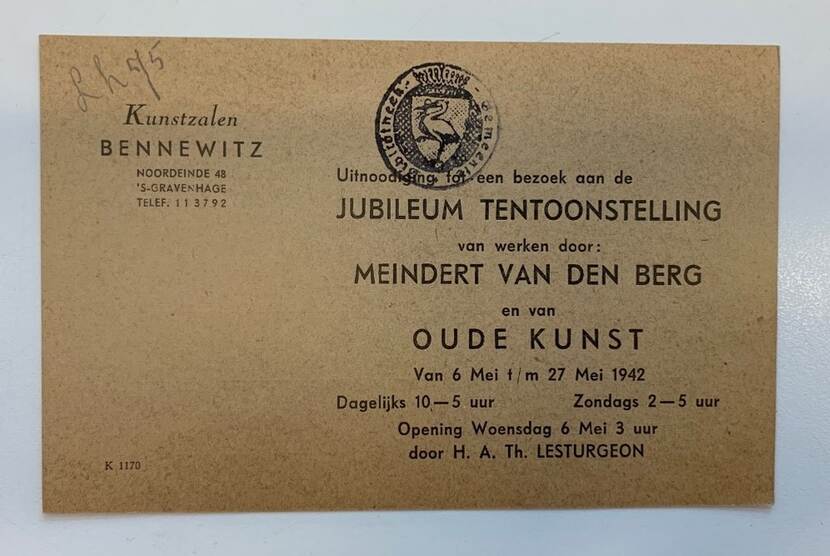In pursuit of provenance: two Dutch scenes
Weblog
In the In pursuit of provenance blogs series, we focus each month on a different object from the Netherlands Art Property (Nederlands Kunstbezit, NK) collection, which is the subject of provenance research. This collection is made up of objects that were returned to the Netherlands after the Second World War. They include paintings, works on paper, as well as furniture and ceramics. By giving this research renewed impetus, we hope to be able to identify new information on provenance.
This month: two early 20th-century paintings by Dutch artist Mijndert van den Berg. Do you have any additional information about these works, including their provenance?
[Text continues below the pictures]


Typically Dutch
This blog focuses on two works: Riviergezicht (River view), Gorcum, 1900-1949 and Brug over de Dieze (Bridge over the River Dieze), ‘s-Hertogenbosch, 1900-1940. Both paintings are from the hand of Dutch artist Mijndert van den Berg (1876-1967). Van den Berg, who was born in Gorinchem, did not choose to become a painter until later in life. Between 1908 and 1916, he studied at the Royal Academy of Art in The Hague. He would live in The Hague for the rest of his life, and this set the tone for his work. Van den Berg was heavily influenced, for example, by the Hague School, which is characterized by the realistic depiction of typically Dutch subjects, such as Dutch landscapes, city and river views and genre pieces.
Van den Berg travelled the length and breadth of the country, seeking inspiration from urban settings as well as nature. He recorded an account of his travels in his book titled ‘Life history and travel sketches of Mijndert van den Berg’ (1949). In this book, Van den Berg provides details of his visits to his hometown of Gorinchem, among other places, as well as ‘s-Hertogenbosch; the places depicted in the paintings concerned. The sketch Van den Berg made in ‘s-Hertogenbosch titled ‘Binnen-Dieze’ is of particular interest. This sketch seems to depict the same scene as the painting titled Bridge over the Dieze, ‘s-Hertogenbosch, albeit that the bridge in the sketch is shown from the other side. It is possible that this sketch was used as a study for the painting.
[Text continues below the picture]


Anniversary exhibition
It is not known when exactly Van den Berg made the paintings. The works are not dated, nor does Van den Berg provide any dates in his life history. However, he does seem to have described his travels chronologically. As a result, we know that he visited Gorinchem several times and ‘s-Hertogenbosch only once.
It is known that Van den Berg organized an anniversary exhibition at Gallery Bennewitz in The Hague in May 1942 to mark his sixty-fifth birthday. In his travelogue, Van den Berg describes this event after his visit to ‘s-Hertogenbosch. It is therefore possible that the painting Bridge over the River Dieze, ‘s-Hertogenbosch, was made before this date. Van den Berg visited his hometown more often, making it more difficult to determine when he created the work titled River view, Gorcum. A review of the exhibition in the De Tijd daily newspaper includes reference to a painting titled ‘Binnen-Dieze’. While there is a possibility that this concerns the work titled Bridge over the River Dieze, ‘s-Hertogenbosch, unfortunately we do not know for sure whether this is the case.
In his life history, Van der Berg writes that the exhibition was a great success for him, including in a financial sense. This implies that the exhibition provided a platform for him to sell a number of works. It is unknown whether they included Bridge over the River Dieze and River view, Gorcum. No catalogue of the exhibition has been found.
Provenance unknown
Besides it being unknown when the paintings were made, nothing is known about the subsequent owners and whereabouts of the works in question. All we know is that the artworks ended up in Germany at some point during the Second World War. A transport list exists, showing that the works were brought to the Netherlands from Frankfurt am Main on 20 September 1951.
An important detail on the transport list is a comment placed alongside both artworks, which reads as follows: ‘Achterz. Orig. Sarrebr.’ This prompted a closer examination of the backs of the paintings. Labels with French writing from Collecting Point Baden-Baden were found on both works (images below). It is possible to make out from the labels that ‘Orig.’ refers to Origine, and ‘Sarrebr.’ to the French name for the German city of Saarbrücken. It seems therefore that the paintings were in Saarbrücken at some point during the war. It is likely that the works were taken to Collecting Point Baden-Baden after the war and then returned to the Netherlands via Frankfurt am Main.
The question remains as to how the works ended up in Saarbrücken and, more importantly, who the owners were. The works were not notified to the Netherlands Art Property Foundation (SNK) by way of a declaration form after the war. A recent information request to the Saarland Museum in Saarbrücken did not throw up any more leads. Perhaps you know something about the provenance of these paintings and who the owner is?
Help wanted
A specialist team of researchers at the Cultural Heritage Agency of the Netherlands (RCE) focuses on new and additional research into the provenance of objects in the Netherlands Art Property Collection (NK Collection). They are also providing digital access to the results of their research and making relevant information and data permanently available. This renewed impetus to research in this area promises to provide an even better picture of the objects.
If you have more information on the provenance of these paintings by Mijndert van den Berg (NK2792 and NK2794), please contact us: restitutie@cultureelerfgoed.nl
This blog was written by Simone van Wijk, junior provenance researcher at the RCE.
----
